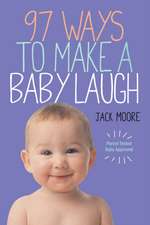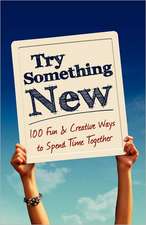The Praeger Handbook of Play across the Life Cycle: Fun from Infancy to Old Age
Autor Luciano L'Abateen Limba Engleză Hardback – 29 iun 2009 – vârsta până la 17 ani
Preț: 350.47 lei
Preț vechi: 478.98 lei
-27% Nou
Puncte Express: 526
Preț estimativ în valută:
67.06€ • 71.71$ • 55.92£
67.06€ • 71.71$ • 55.92£
Carte tipărită la comandă
Livrare economică 17 aprilie-01 mai
Preluare comenzi: 021 569.72.76
Specificații
ISBN-13: 9780313359293
ISBN-10: 0313359296
Pagini: 360
Ilustrații: black & white illustrations, black & white tables, figures
Dimensiuni: 156 x 235 x 33 mm
Greutate: 0.7 kg
Editura: Bloomsbury Publishing
Colecția Praeger
Locul publicării:New York, United States
ISBN-10: 0313359296
Pagini: 360
Ilustrații: black & white illustrations, black & white tables, figures
Dimensiuni: 156 x 235 x 33 mm
Greutate: 0.7 kg
Editura: Bloomsbury Publishing
Colecția Praeger
Locul publicării:New York, United States
Notă biografică
Luciano L'Abate is a fellow of the American Psychological Association, co-founder and past president of the International Academy of Family Psychology, and professor emeritus at Georgia State University, Atlanta, GA.
Cuprins
Foreword by Arthur M. HornePrefaceAcknowledgmentsPart I. Definitions and a Bird's Eye View of Play1 Come, Let's Play2 Play across History and into Cyberspace3 What the Experts Say about Play4 What Cultures Have to Do with Play5 What Parents and Adults Have to Do with Play and Gender6 Chronological Age Is Not the Same as Development in PlayPart II: Chronological Stages of Play7 Infancy8 Nursery, Preschool, and Kindergarten9 Elementary School10 Middle School and Puberty11 High School and Adolescence12 College and Early Adulthood13 Adulthood, Middle Age, and Old AgePart III: The Usefulness of Play14 Physical, Emotional, Intellectual, and Relational Benefits15 In Their Best Interest: Play Therapy for Children16 Play as RehabilitationPart IV: Controversies about Play17 The Technology of Play Time and of Media Time18 What Teachers and Coaches Think about PlayPart V. Conclusion19 A Hierarchical Theory of Play CompetenceReferencesAppendix A ResourceszAppendix B Monitored Play TherapyAppendix C An Experimental Theory-Derived Structured Play InterviewIndexAbout the Author
Recenzii
L'Abate (emer., Georgia State Univ.) has written a valuable reference detailing the central role that play, in its many forms, has in the epigenetic life cycle, from infancy all the way to old age. In doing so, he fills in an epistemological gap usually not acknowledged in personality theory. He covers in detail every aspect of play: its varied manifestations across the life span, its relevance to personality and social development, prevailing cultural attitudes towards it, and how it is instrumental in aiding various populations (e.g., individuals with disabilities, aggressive youth). All the various strands come together in a multifaceted hierarchical paradigm that presents an integrative conceptual structure highlighting the elements of play. The references cited are extensive and the narrative is easy to follow, sprinkled with personal anecdotes and vignettes about L'Abate's grandchildren. Linking theory to therapeutic intervention, this is a superb reference for all concerned with play development. Summing Up: Essential. Lower- and upper-division undergraduates, graduate students, professionals, general readers.
For psychologists, psychiatrists, other mental health practitioners, play therapists, leisure time and recreation specialists, and scholars of development and personality, L'Abate (clinical psychology, Georgia State U., Atlanta) examines the history of play, details how it affects people from infancy to old age, and argues for its importance to physical, intellectual, emotional, and spiritual well-being. He illustrates how people play at different stages of the life cycle and how it is part of development and socialization, as well as the consequences of its changes today. He also discusses its benefits and applications in therapy and rehabilitation and controversies over play, including technology, the media, and education.He excludes discussion of animal play, advocacy and theory, and neurological and cerebral functioning.
Toward this end, the author frequently interjects anecdotes from his own life and the lives of his family and friends. These stories serve as miniature case studies that illustrate relevant theoretical and empirical points in a manner that makes his book all the more enjoyable. . . . This handbook is best read from beginning to end but also is the type of book one may read in parts, as a reference or as guided by one's interests. . . the volume would make an excellent starting point for a graduate student beginning a research program in play. Of course, the handbook would also serve as a superb tool for the seasoned psychologist or psychotherapist to update his or her knowledge of a field that has evolved considerably in recent years as lifestyle and technology changes, including the invention of the popular Nintendo Wii, have altered the way many play. The addition of several helpful appendices makes the volume all the more attractive for such purposes. For instance, Appendix A offers an annotated bibliography of some significant sources, including books, journal titles, professional organizations, and websites. University libraries will want to own this book, as will many public libraries as well.
The inclusion of the topic of adult play solidifies its must-read status for scholars interested in understanding diverseexpressions and functions of play..It is clearly written and can serve as a necessary textbook for graduate-level courses that focus on the study of play and leisure across the lifespan. The Praeger Handbook of Play across the Life Cycle is an engaging, extensive overview of play from different perspectives, emphasizing play as a valuable activity for individuals of all ages.
For psychologists, psychiatrists, other mental health practitioners, play therapists, leisure time and recreation specialists, and scholars of development and personality, L'Abate (clinical psychology, Georgia State U., Atlanta) examines the history of play, details how it affects people from infancy to old age, and argues for its importance to physical, intellectual, emotional, and spiritual well-being. He illustrates how people play at different stages of the life cycle and how it is part of development and socialization, as well as the consequences of its changes today. He also discusses its benefits and applications in therapy and rehabilitation and controversies over play, including technology, the media, and education.He excludes discussion of animal play, advocacy and theory, and neurological and cerebral functioning.
Toward this end, the author frequently interjects anecdotes from his own life and the lives of his family and friends. These stories serve as miniature case studies that illustrate relevant theoretical and empirical points in a manner that makes his book all the more enjoyable. . . . This handbook is best read from beginning to end but also is the type of book one may read in parts, as a reference or as guided by one's interests. . . the volume would make an excellent starting point for a graduate student beginning a research program in play. Of course, the handbook would also serve as a superb tool for the seasoned psychologist or psychotherapist to update his or her knowledge of a field that has evolved considerably in recent years as lifestyle and technology changes, including the invention of the popular Nintendo Wii, have altered the way many play. The addition of several helpful appendices makes the volume all the more attractive for such purposes. For instance, Appendix A offers an annotated bibliography of some significant sources, including books, journal titles, professional organizations, and websites. University libraries will want to own this book, as will many public libraries as well.
The inclusion of the topic of adult play solidifies its must-read status for scholars interested in understanding diverseexpressions and functions of play..It is clearly written and can serve as a necessary textbook for graduate-level courses that focus on the study of play and leisure across the lifespan. The Praeger Handbook of Play across the Life Cycle is an engaging, extensive overview of play from different perspectives, emphasizing play as a valuable activity for individuals of all ages.








